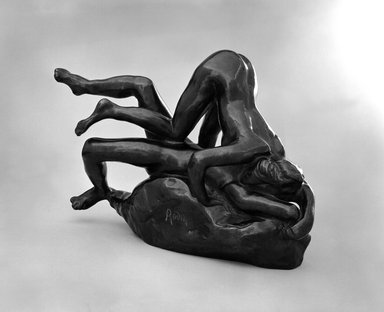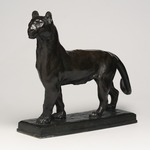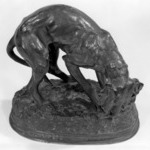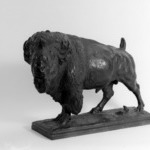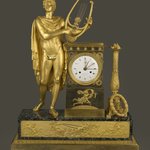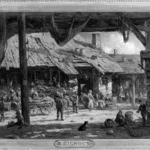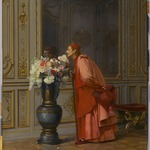Is there any bronze cast of the gates of hell in any museum around the world or does only the plaster version survive?
Yes, you can see a bronze cast in the Musée Rodin in Paris, the Rodin Museum in Philadelphia, and at Stanford University to name a few.
That one in Philadelphia was the first cast made from the artist's plaster models. It was cast in 1925. Rodin never finalized the Gates, but a mold was posthumously assembled from all of the separate figures he created with the intention of including them in the composition.
I find it fascinating that this commission, although never completed, was the source of so much inspiration for the artist.
Are The Gates of Hell at Stanford University the original one?

The simple answer is no, but it is also important to know that Rodin never finished The Gates of Hell himself. Scholars have, however, assembled Rodin's plans to create posthumous casts of the work, like the example at Stanford. The Gates on the Cantor Arts Center (the same Cantors who donated all of the Rodin works in this exhibition) is the fifth cast from the posthumous mold created at the Musée Rodin.
Thank you!
Can you tell me more about what a commission is or was for an artist like Rodin? Gates of Hell for example?
Sure! In general, commissions are essentially jobs. An individual or group hires an an artist to create a work, often based on their specific desires and needs.
For instance, Rodin was hired by the French government in 1880 to create an entranceway to a proposed museum of decorative arts in Paris. Rodin chose the theme for the Gates of Hell based on the government's needs for the work while taking influence from 15th century Italian sculptor Ghiberti's Gates of Paradise in Florence.
Thank you!
What in the Gates of Hell is based on/inspired by Baudelaire?
In terms of what is in this exhibition, you’ll notice “Damned Women,” one of many sculptures that was to be included in the Gates of Hell composition, is titled after a poem about lesbian love of the same name in Baudelaire’s Flowers of Evil.
What is the connection for Rodin to Hell, such as the Gates of Hell? Was there spiritual influence in his life?
I would say that hell was more of an artistic influence than a spiritual one. He used the subject to explore a range of subjects, including sensuality, athleticism and various types of love.
I think the subject of hell appealed to him because it was so richly described in literary history (Dante Aligheri’s The Inferno, the Bible, etc) and he saw the opportunity to give a physical, aesthetic form to descriptions of hell.
Interesting
Something I find interesting is that a lot of the most risqué figures that came out of the Gates of Hell project were never exhibited in his lifetime. For example , the "Damed Women" sculpture was too blatantly erotic for most 1885 viewers.
Acerca de The Gates of Hell, Rodin primero esculpió en mármol y después lo usaba de modle para el bronce? Como era su técnica?
Rodin esculpió primero en arcilla y después hicieron un molde de escayola. El molde se haría con un escayola resistente al calor para soportar la alta temperatura del bronce fundido.
Ok, ahora me quedó claro. Gracias.
Why did Rodin not finish the Gates of Hell?
He died before he had the chance to complete the Gates of Hell. It was never fully assembled and cast in bronze during his lifetime. He also saw the project as a great opportunity for experimentation, artistic inquiry, and invention, and so worked on it after the commission for the work had fallen through in the 1880s.
Because the original commission fell through, he didn't have to adhere to a strict timeline and was free to just keep experimenting with the forms and figures in the work!
What is going on here?

This sculpture depicts two women giving into their desires for one another. The sculpture was conceived as part of The Gates of Hell project.
Rodin was likely responding to a book of erotic poetry published by Charles Baudelaire that described women as having sexual desire. This concept was a revelation in a time of strict moral codes of behavior for women.
Interestingly, Damned Women was never exhibited during Rodin’s lifetime, due it its blatant eroticism.
That’s fascinating, thank you.
What’s the meaning behind the three men standing on the top of the gates of hell?
The three figures at the top of the Gates of Hell are the three shades, characters from Dante Aligheri's Divine Comedy. In his writing, the shades represent the souls of the damned who stand at the entrance to Hell. Notice they are pointing down. They are pointing to the message “Abandon hope, all ye who enter here”
Thanks a lot!
The Gates of Hell is in Philadelphia now, but where was it originally made and in use?
The Gates of Hell was originally commissioned by the French state in 1880, to be placed in a prospective Museum of Decorative Arts in Paris. The museum was never built and the commission was cancelled.
Still, Rodin continued to work on the piece and a limited run of bronze versions of the work were cast after his death.
So really, there is no one existing place where the Gates of Hell were originally in use, but casts can be seen today in Paris at the Musée Rodin, in Philadelphia, Stanford, Zurich, Seoul, Mexico City, and Tokyo, and a plaster version at the Musée d'Orsay in Paris.
Tell me more about the Gates of Hell.

The Gates of Hell was probably one of the most ambitious projects that Rodin embarked on. It was never cast during his lifetime though but, according to his designs, a limited number of bronze casts have been made posthumously.
For the project, Rodin modeled hundreds of figures from Dante's Divine Comedy, the Bible, and Classical mythology. After the commission was canceled, he recycled, reduced, fragmented, or recombined many of the figures and recast them as independent sculptures, the most famous of which is The Thinker seen here at the center of the lintel.
The exhibit states there are a few casts of the Gates of Hell. Where are they?
Though the original commission fell through, a mold of The Gates of Hell has been pieced together from Rodin's designs. There are doors cast from the mold at the Musée Rodin in Paris as well at the Rodin Museum in Philadelphia and at locations in Stanford, Zurich, Seoul, Mexico City, and Tokyo.
Thank you!
Is the small figure top left of the Gates of Hell a model for the larger work The Shade?

Essentially, yes! All three figures at the top of the Gates are meant to be shades, but there are versions of each figure separately.
Was Rodin's "Thinker" recycled from The Gates of Hell?

Basically yes! The Gates of Hell were never completed during Rodin's lifetime, but he did create sculptures of many of the individual figures featured in the final composition.
What we know as The Thinker is indeed that central figure and he is meant to represent the author, Dante Aligheri, of The Divine Comedy (including The Inferno).
Cool! Thanks!
Is there any information on what inspired Rodin to create the Gates Of Hell?
The Gates were commissioned by the French government to be the entrance to a museum of decorative arts in Paris. Ultimately, the museum was never built, but the Gates have since been cast for other institutions including the Rodin Museum in Philadelphia.
The design of the Gates of Hell is based on the writings of Dante Aligheri's The Divine Comedy which include The Inferno, a description of the geography of Hell.
Is that a work that he studied in depth?
Rodin was certainly very interested the Dante's writing and The Divine Comedy remains a very popular book to this day.
Some of Rodin's favorite characters were Paolo and Francesca, a pair who lusted after one another despite other relationships in their lives. They were condemned to be intertwined, but never to consummate their lust.
Is "The Thinker" in the Rodin exhibit?
The Thinker is not in the Rodin exhibition. However, "The Thinker" does appear in Rodin's "Gates of Hell", which we have a good amount of material from, in addition to a 2-D reproduction of in the exhibition.
In the "Gates of Hell", "The Thinker" can be found in the center, right above the doors.
Were Rodin and Baudelaire contemporaries? If so did they associate?
Yes, they were contemporaries. Rodin respected Baudelaire immensely. HIs influence can be seen in the sculpture "Damned Women." The title of this work was taken from Baudelaire's collection of erotic poems, "Flowers of Evil."
That's immediately what I thought of! thank you for your help.
You're welcome! Rodin illustrated an edition of Les Fleurs du Mal, and also sculpted a monument to Baudelaire. However, both of those projects were completed after the poet's death in 1867.
Fleurs du mal is a personal favorite of mine.
It was a very progressive work in its time! The idea that women could have sexual desire ran counter to prevailing ideas about gender. Even "Damned Women" was never exhibited during Rodin’s lifetime because it seemed too blatantly erotic for public sensibilities.
I can imagine. Baudelaire was deliberately provocative and it seems the work he inspired was no less so.
Absolutely! Their fearlessness seems to have served them both well, as they are now part of the artistic and literary canon.
:) thank you for all your help




